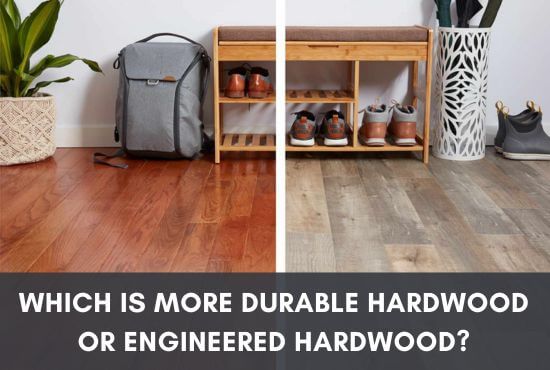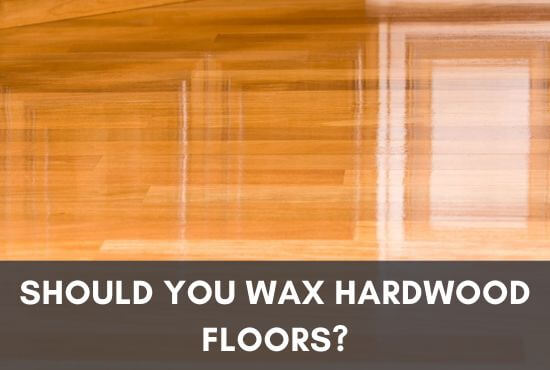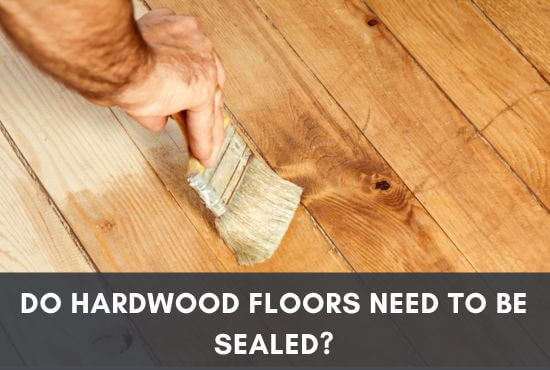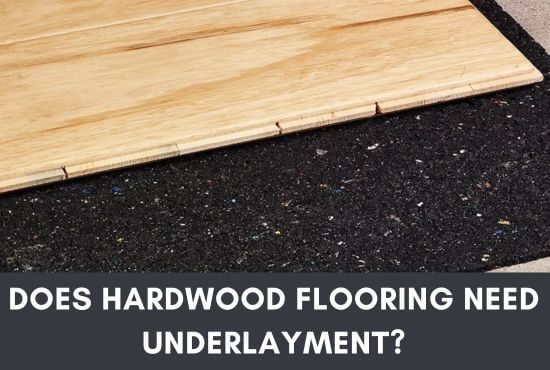Porcelain tile and hardwood are both exquisite floorings and their never ending debate is about to end today. While both of these are very popular and renowned, they have their pros and cons.
Porcelain tile is known for its ability to resist water, making it a great option for moisture-prone areas such as bathrooms and kitchens. On the other hand, hardwood floors are more susceptible to moisture damage, necessitating special care to avoid warping or cracking.

If you want a wood-like appearance in an affordable budget with low upkeep, porcelain is your best pick. If you want a more luxurious flooring choice and maintenance or budget is not a problem, you must choose hardwood.
Let’s discuss this in detail.
Table of Contents
What Are Hardwood Floors?
Hardwood floors are wooden flooring boards that are purely made from natural hardwood. They might have undergone some chemical treatments to increase durability and other factors, but they do not have any composite or artificial content.
The treatment makes it resistant to rotting and decaying, which becomes one of the basic reasons for its prolonged longevity. Hardwood is cut into boards and installed on a subflooring platform to make a beautiful structure of wooden flooring inside the house.
Hardwood floors come in various sizes, colors, and varieties for you to choose from. Ranging from oak to mahogany and many more, there is a lot you can explore in the hardwood section.
Besides, all hardwood types are considered unique and luxurious. Some rarer types of hardwood, which are not easily grown, are extremely expensive and can only be afforded by the wealthiest.
In short, hardwood is only made for those who have a subtle taste and can afford it. For those who want a similar experience but in a lesser price range, engineered wood is the most suitable option for them.
It is a subcategory of the original hardwood and contains a mixture of composite materials such as PVC and plastic.
It is branched from the hardwood category, and gives a similar appearance and experience but only in a smaller budget.
Also Read: Somerset Vs Bruce Hardwood Floors
What Are Porcelain Tiles?
Porcelain tiles are another popular type of flooring which are suitable for both domestic and commercial uses.
They are wood-like tiles, but the main difference is that they only give an appearance of wood and have no actual wood content in them.
When clay is exposed to extremely hot temperatures from 2000-2500 F, porcelain is made. It is sometimes known as the high-fire material for the same reason.
Porcelain is a very durable product as it is made in extreme temperatures and can withstand a lot of pressure and heat.
Besides, it also gives a very large variety of colors, sizes, and designs so you can choose what’s best for you and get the most appropriate flooring for your house.
According to the design and type of tile you’ve chosen, the price of the porcelain tiles can vary to a certain extent.
However, many people compare wood-like porcelain with hardwood floors and even consider that porcelain is better than hardwood in almost all areas.
While hardwood enthusiasts strongly disagree with this perspective, we decided to give this topic an unbiased discussion.
What Is The Difference Between Porcelain Tile And Hardwood Floors? | A Detailed Analysis
Both porcelain and hardwood floors are extremely good in their respective genres, and they are not to be compared solely for the purpose of entitling one superior to the other.
However, if you are looking forward to renovating your house or getting a new house constructed and you do not know which flooring you should get, we’ve got you covered.
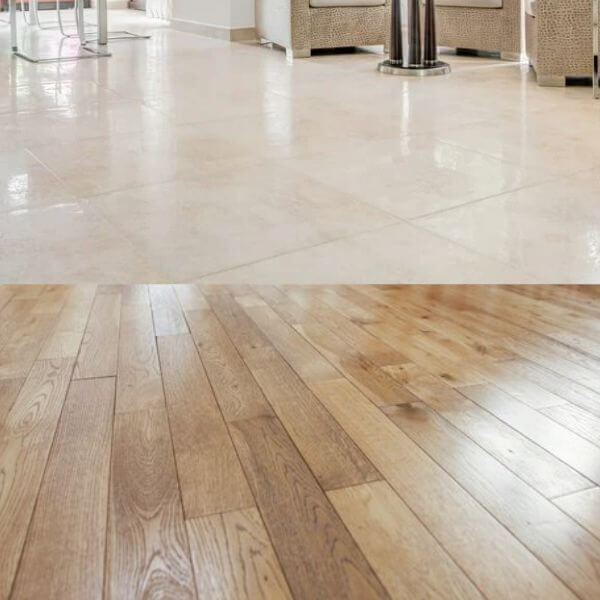
We’ve discussed all the important factors you need to know about both of these flooring options so you can choose better.
Read the comparison below, and you will surely be able to find out the best flooring option according to your condition and preferences.
Get to know about Satin Vs Semi Gloss Hardwood Floors.
Durability
Durability is one of the most important factors to consider when selecting a flooring material for your home.
If the flooring is not durable enough, you will not only lose your initial investment, but the floors will also require constant maintenance, which will be an added expense.
Besides, it can be a nuisance if the floors are requiring repairs every now and then as you won’t be able to carry on with the regular chores. way.
While porcelain and hardwood are both very durable flooring options, you must be looking forward to choosing the best among them. Let’s find out which one is more durable.
- Hardwood
Natural hardwood is quite durable and can take a lot of traffic and pressure. However, this is only possible after it has been stained and sealed, as the bare wooden surface will not last very long.
Besides, even after these measures, the hardwood floors are prone to various dangers.
For instance, warping, scratches, dents, and cracks are some common issues faced by every homeowner who has hardwood flooring installed in their house.
This increases the amount of repairs and maintenance, which will be discussed later on, for you.
Though this does not mean that hardwood is completely useless, it surely has some drawbacks, and constant upkeep is required to sustain the durability of the floors.
- Porcelain
Porcelain tiles are very strong and durable when compared to hardwood. As they are made in extremely high temperatures, they are very dense and concentrated, which allows them to be able to take a lot of traffic and pressure without showing any signs of weariness.
Moreover, the surface does not require any specific staining or sealing. In fact, it is resistant to stains and water which makes it highly suitable for high-traffic areas and other such purposes.
This also means that a lot less upkeep of the floors is required, and you do not have to worry about constant repairs.
Even if you have double the traffic you expected as the highest; you won’t have to face any issues as the porcelain tiles with a wooden look can easily handle the pressure.
Appearance
Spending high sums of money on any flooring option will certainly increase your expectations from the floors justifiably. Having a wooden look on the floors is a dream for many people, and it is possible with both hardwood and porcelain, but choosing one is mandatory.
Therefore, whether it is porcelain or hardwood, it is your right to get the right appearance from your floors which is sustained over the years and also matches the theme of your house.
Prefinished Or Site Finished: Which Hardwood Floors Are Best?
- Hardwood
Hardwood floors are extremely diverse and give you a lot of variety. There are darker variations, such as maple, mahogany, walnut, and wenge.
On the contrary, the lighter tones of oak and many other hardwood types are equally palatable.
Besides, they have a greater diversity in patterns and textures which allow you to choose the right specifics you want for your floors.
However, the wide variety in terms of species and wood colors is not all, as there is still an option for staining.
While the diverse array of color selections available in solid hardwood was something you would love, staining takes this to another level.
It allows you to get the right hue on your hardwood floors or make them darker/lighter if necessary. This enables customization and syncs the floors with the overall theme of the house.
In addition, the tight seams of hardwood floors make them look much more refined and streamlined. Moreover, you can also get solid hardwood flooring on sealed and non-sealed surfaces.
- Porcelain
Porcelain tiles also have a wood-like appearance which is the desire of many homeowners. The variety of designs, colors, textures, and sizes is almost unlimited when it comes to porcelain. From light coffee colors to darker charcoal shades, porcelain has it all.
There is no limit to the variety of porcelain, as it gives you anything and everything you want. However, as it does not allow any stains, you won’t be able to get any customization of hues or shades according to the theme of your house.
In addition, porcelain is wood-like but not wood. This makes it quite visible, and you will always have a wood-like appearance which will easily be identified. This means that you can mimic the wood’s appearance but not have something exactly like wood.
Therefore, if the merit for appearance is wood’s texture and colors, hardwood certainly has the lead. Whereas the porcelain tiles take the section of variety and diversity due to their extensive options in colors and textures.
Comfort and Sound
What use are expensive floors if they cause pain in the feet and are not comfortable to walk on?
You might be thinking the same question, and hence, we are here to discuss the comfort of both these flooring options to check which one is the most comfortable so you can choose that.
Besides, sound absorption is another important factor in this topic, as hollow sounds can be a nuisance for you and your neighbors downstairs (if you live on the first floor or up). So, let’s get into this topic and see which one takes the lead.
Hardwood Floor Resurfacing Vs. Refinishing: Which Is Better?
- Hardwood
Hardwood floors are quite rigid, but as they are installed on a subflooring platform, and there are usually sealants and underlayments used, they are reasonably comfortable.
They allow a decent amount of compression, which allows the hardwood floors to be suitable for walking
Whether you are treading on them with shoes or barefoot, they are not very stiff and hence, give a suitable feel to your feet.
However, hardwood floors do make some hollow sounds. If there is no underlayment installed, these can be quite loud, but if you have a sub-layer, the sounds will be muffled. But you can’t expect the hardwood floors to be extremely quiet.
As they have some hollow spaces in the subflooring structure, they are prone to such sounds, and underlayments or walking barefoot are the only two solutions you have to this problem.
- Porcelain
Porcelain is not very comfortable to walk on. As the platform is very rigid and stubborn, it does not give the user a very friendly experience.
Especially if you have any problem related to joints or you get frequent muscle spasms in the feet or legs, porcelain might not be the best option for you.
You can either get area rugs or medicated insoles for your shoes, as walking barefoot on the porcelain floors will increase your pain.
As far as sound absorption is concerned, tiles are not very good at it. Being fair, porcelain and hardwood give off the same amount of hollow sounds when you tap them or walk on them.
However, hardwood floors can get this muffled through underlayment, but this is not very common in porcelain tiles.
Therefore, we can conclude that hardwood floors are far more comfortable than porcelain tiles, and if used in combination with a sub-layer, they are also very efficient at stopping hollow sounds and preventing loud noises from escaping the area.
Water & Heat Resistance
Water and heat are some of the most common reasons for flooring to be damaged. Hence, every homeowner wants their floors to be resistant to these factors to some level.
Not only does this increase the resilience and durability of the floors, but it also increases their longevity as they won’t be damaged as frequently.
Let’s have a look at which one of these two is more resistant to heat and water.
- Hardwood
Hardwood floors are resistant to heat to a great level. Even though they are made of natural substances, they can still withstand extreme amounts of heat.
Be it your kitchen or a very hot day, both can easily withstand heat without demanding extra care or treatment.
Although heat does not damage the floors as much, direct sunlight might cause the color to fade over time.
However, having a sealant on top is very beneficial in this scenario as it prevents the stain and the color from evaporating from the surface.
Wood is known to be cool naturally, and if you live in a hotter environment, hardwood floors will certainly not disappoint you.
As far as water is concerned, hardwood is certainly not the ideal option as it can get damaged by water very easily.
The primary reason behind the floors having a requirement to be finished frequently is that they are prone to water damage.
While hardwood is resistant to moisture to some extent, it gives up after a certain level of moisture is reached in the wood.
Hence, you can get it installed easily in normal rooms and areas, but you have to be extremely careful when installing these in the kitchen or bathrooms. It can be deduced that hardwood is not suitable for areas with “high moisture content.
Whether finished or not, hardwood has a porous surface that can absorb much moisture, causing many problems and damaging wooden planks. Besides, installing hardwood directly on concrete or the ground without any moisture barrier is also not recommended.
- Porcelain
Porcelain is the best option among most of the flooring available in the market. It is highly resistant to water content and does not give in to humidity very easily.
Besides, if you finish it with any suitable finish, you will see that your floors are not disturbed even by spillages or leakages, let alone the general moisture in the area.
This makes the porcelain an excellent choice for areas with high moisture, such as the bathroom and the kitchen.
As for the heat, you can’t have anything or any flooring option compared to the porcelain tiles in terms of heat tolerance.
As they are made in extremely high temperatures, they are extremely tolerant towards heat and do not give in to the highest temperatures.
Besides, they are also fire-proof, which means that in case of any unprecedented accident, the porcelain tiles will not get damaged.
Affordability
Being affordable is one of the most important attributes a wooden flooring needs to have. As flooring is quite an expensive part of any renovation or construction process, the homeowners expect something worthy of their expenses.
Now that we’ve listed most of the important factors of both these flooring options, choosing the right one according to cost will be much easier. This way, you can get a better idea of which flooring gives better value to your money.
- Hardwood
We all know that hardwood floors are considered to be extremely expensive. As they are considered a luxury, the common perception is that not many people can afford them.
However, reality begs to differ, as you can now get affordable types of hardwood as well.
These newer types are available in abundance, which decreases their cost, but you must know that they are not as exquisite as the high-end ones. The top-tier hardwoods are very difficult to source; hence, they are highly-priced.
The average range of hardwood flooring is between $4 to $35. However, this sum does not include any other expenses apart from the flooring cost.
Adding other factors, such as labor, installation charges, and transportation costs, can increase the cost from $3 to $10 per square foot.
A general breakdown for a room of 10×5, which is 150 sq. ft, is as follows. Provided the average total cost is $7-45, such a room will cost you somewhere between 1050 to 6750 dollars depending on what type you’ve chosen.
Furthermore, this does not include the staining and finishing cost, which can be another expense and might cost you up to 2000 dollars for both procedures.
- Porcelain
A general perception is that porcelain is cheaper than the hardwood floors. While this is true to some extent, it is not completely right.
Porcelain is certainly more affordable than average hardwood floors; however, after a certain point, the cost of porcelain is almost the same as hardwood floors.
The difference in affordability comes in the installation and labor charges, where porcelain takes the lead.
Moreover, there is no staining for the porcelain floors as they do not accept any stain. Finishing them is totally optional and not necessary.
Provided this, the average cost of porcelain tiles is around 2-30 dollars per square foot. Adding the other charges will take it up to 4-27 dollars. Keeping the original estimation in mind, the average cost for a 150 sq. ft room would be somewhere between $600 to $5550.
However, there is no additional cost for any underlayment, sealing, or staining of the floors. This makes the entire process much more affordable. Therefore, allowing you to save up to 2000 dollars on the entire project.
Maintenance
Maintenance is an important factor when it comes to choosing any flooring type, as the amount of maintenance required for the floors is the key to having an easy life or a routine packed with chores.
Therefore, it is best to know this beforehand so you can choose accordingly and make the best decision for you.
- Hardwood
Hardwood floors are pretty simple to clean as all you must do is clean the dust, spills, or build-ups from the surface. They can be swept, mopped, and dam-mopped without effort, and overall cleaning is not very complex.
Even if the floors get a buildup due to lack of cleaning, it is very easy to remove and does not require too much effort.
However, this can be easily avoided through daily vacuuming and dry mopping.
Another part of maintenance is the refinishing process which needs to be done once every few years.
This is done to recoat the floors with the finishing material so they get the right protection throughout.
Sanding is often involved in this process which refreshes the grain of the wooden flooring and makes them appear much newer than before. This process is only done once every 3-5 years, so it’s not a big deal.
- Porcelain
Porcelain does not require much upkeep. Apart from the general cleaning and polishing of the tiles, you do not need to do a lot with it. There is no refinishing required; however, buffing the floors once in a while might be good to maintain their shine.
Hence, porcelain is certainly better in terms of maintenance as it is very easy to maintain and does not require any additional procedures.
Conclusion
We hope this article on porcelain tile vs hardwood floors was helpful in deciding between both the flooring options. If it helped you make the right decision, do let us know!
John Henry is a passionate co-creator of FlooringFlow.com. a website dedicated to answer all of your flooring related questions. After taking the challenges of flooring DIYs while learning skills for years, John is now ready to share his knowledge related to floor remodeling and projects with you.

![70 Bedroom Color Schemes: [year] Home Bedroom Refresh 70 Bedroom Color Schemes: [year] Home Bedroom Refresh](https://flooringflow.com/wp-content/uploads/2024/07/25-Cool-4th-of-July-Decorations-for-Outdoor-Patio-to-Celebrate-in-Style-16.jpg)
